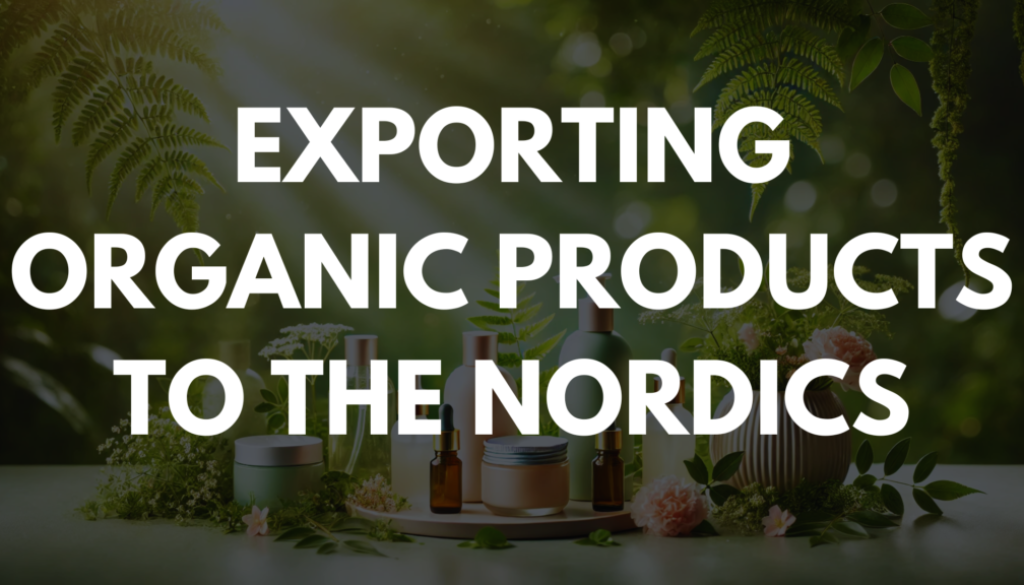Exporting Organic Products to the Nordics
Last Updated on 19. Dec 2024 by b2bexport
Are you a business owner contemplating to exporting organic products to the Nordics countries?
If the prospect of entering these markets for the first time seems overwhelming, you’re not alone. In this blog post, we’ll address 12 critical questions and provide answers related to exporting organic products to Denmark, Finland, Norway, and Sweden. Let’s begin unraveling this potentially complex process to help your business seize its financial advantages.
1. What is the Difference Between Organic and Sustainable Products?
Organic Products and Sustainable Products:
Understanding the Differences and Benefits Organic products and sustainable products both strive to minimize environmental harm and uphold ethical practices, yet they differ in several key aspects.
What are Organic Products?
Organic products encompass agricultural items and foods produced without synthetic fertilizers, pesticides, genetically modified organisms (GMOs), or other synthetic substances.
These products rely on natural farming methods such as crop rotation, composting, and biological pest control. Organic livestock farming involves raising animals without antibiotics or growth hormones. Organic products are regulated and certified to ensure they meet specific production and quality standards. In the United States, the USDA’s National Organic Program (NOP) sets these standards, while in Europe, products must comply with EU organic certification requirements. The popularity of organic products is driven by perceived health benefits, environmental sustainability, and ethical considerations.
They include categories such as fresh produce, meat and poultry, dairy, grains, and packaged foods.
What are Sustainable Products?
Sustainable products are designed, produced, and disposed of in ways that minimize environmental impact and promote ethical practices throughout their life cycle.
They consider environmental, social, and economic impacts from production to disposal. Key features include:
- Use of Renewable Resources: Utilizing renewable materials and resources, such as recycled materials or sustainably sourced components.
- Reducing Waste: Designing for durability and repairability, using recyclable or compostable materials, and minimizing packaging.
- Ethical Labor Practices: Prioritizing fair labor practices with certifications like Fair Trade or Rainforest Alliance, ensuring fair wages and safe working conditions.
- Environmental Impact: Reducing negative environmental impacts, such as greenhouse gas emissions and toxic materials usage.
Sustainable products cover a wide range of items, from clothing and household goods to electronics and vehicles.
Companies are increasingly adopting sustainable practices due to growing consumer demand for responsible products.
Comparing Organic and Sustainable Products
While organic products adhere to specific regulatory standards, sustainable products address a broader spectrum of environmental and social factors.
Both promote ethical and eco-friendly practices but achieve these goals through different approaches. Organic products focus on the agricultural and food production process, ensuring soil quality, avoiding synthetic fertilizers, and maintaining natural resources. Sustainable products encompass a wider array of goods and emphasize the entire lifecycle of a product, from production to disposal, considering economic, social, and environmental sustainability.
The integration of organic farming and sustainable practices contributes significantly to a sustainable world.
By choosing certified organic and sustainable products, consumers can support efforts to reduce the environmental footprint, promote social equity, and ensure the long-term viability of our planet. Both organic and sustainable development are essential in addressing climate change, biodiversity loss, and ensuring the ability of future generations to meet their needs.
In conclusion, understanding and supporting organic and sustainable products not only benefits human health and public health but also fosters a more sustainable world for the distant future.
2. Which Nordic Country Consumes the Most Organic Products?
Denmark leads the Nordic countries in organic product consumption per capita, followed closely by Sweden. In 2020, Denmark had the highest global organic market share, with 12.1% of its food sales being organic.
Sweden followed with a 10.3% market share, while Norway and Finland had 5.6% and 2.6% respectively.

Top 10 Organic Products in Denmark
In 2020, the top 10 organic products favored by Danish consumers were:
- Bananas (66.5%)
- Plant-based dairy (64.9%)
- Carrots (47.6%)
- Oatmeal (47.2%)
- Natural yogurt (47.0%)
- Root vegetables (45.4%)
- Cabbage (36.2%)
- Milk (34.3%)
- Flour (33.7%)
- Eggs (31.2%)
(Source: GfK ConsumerScan)
The table highlights the value shares of the total organic turnover per category for 2020.
The Nordic Commitment to Sustainability
All Nordic countries exhibit a relatively high consumption of organic products compared to many other regions globally.
There is a strong interest in sustainability and environmentally-friendly products throughout the Nordic region.
Emphasizing Organic Agriculture and Sustainability
Denmark’s commitment to organic agriculture is a key factor in its leadership in organic product consumption.
Organic farming practices in Denmark focus on maintaining soil quality, reducing the environmental footprint, and ensuring long-term viability. By prioritizing organic foods, Denmark supports environmental health, public health, and sustainable development.
Economic and Environmental Sustainability
Economic sustainability in the context of organic agriculture involves supporting local farmers and ensuring that farming practices are viable for the distant future.
Environmental sustainability is achieved by avoiding synthetic fertilizers and pesticides, reducing biodiversity loss, and mitigating climate change impacts. Organic certification and the availability of certified organic products also play a crucial role in consumer trust and market growth.
Social Sustainability and Future Generations
Social sustainability is another important aspect, as the practices ensure social equity and the well-being of communities.
The focus is on meeting the needs of the present without compromising the ability of future generations to meet their own needs. This approach aligns with the sustainable goals outlined by the United Nations and the World Commission on Environment and Development.
The Role of Technology and Research
In recent years, advancements in technology and research have further supported the growth of organic agriculture.
These developments help in optimizing supply chain processes, enhancing the quality of organic produce, and ensuring that the benefits of organic foods reach a broader audience.
Consumer Preferences and Market Trends
Consumer preferences in the Nordic region reflect a growing concern for human health, environmental impact, and the sustainability of natural resources.
The popularity of farmers markets and the increasing demand for organic dairy products, such as plant-based dairy and natural yogurt, highlight this trend. Denmark’s leadership in organic product consumption is a testament to its commitment to sustainability, environmental health, and economic development. By fostering a sustainable world through organic farming and responsible consumption, Denmark sets an example for other countries to follow.
The focus on organic products, environmental sustainability, and the ability of future generations to meet their needs ensures a healthier, more sustainable future for all.
3. Which Nordic Country Consumes the Least Organic Products?
Finland has the lowest per capita consumption of organic products among the Nordic countries, with a 2.6% organic market share in 2020.
Despite this, interest in organic and sustainable products is growing in Finland. Finnish consumers are increasingly aware of the environmental and health benefits of organic products, which is driving market expansion.
4. Is Organic Food More Popular in Norway or Finland?
Organic food is more popular in Norway than in Finland. In 2020, Norway’s organic market share was 5.6%, compared to Finland’s 2.6%.
Both countries have relatively high organic product consumption compared to other regions, reflecting a strong interest in sustainability and environmentally friendly products.
5. Which Nordic Country Imports the Most Organic Goods?
Denmark imports the most organic goods among the Nordic countries.
It has a robust organic market and is a global leader in organic agriculture and production. Denmark’s strong economy and prominent food companies drive significant imports of organic products, reflecting growing consumer interest in organic and sustainable goods.
6. Where Do the Nordic Countries Import Organic Goods From?
Nordic countries import organic goods from various global sources.
Key exporters include:
- Germany
- Netherlands
- Spain
- Italy
- Denmark
- France
- United States
- Turkey
- Greece
- China
These countries are major producers of organic products such as fruits, vegetables, grains, and meat.
7. Where Do the Nordic Countries Import Organic Skincare Products From?
Nordic countries source organic skincare products from diverse international markets. Top exporters include:
- United Kingdom
- Germany
- France
- United States
- Italy
- Denmark
- Switzerland
- Spain
- Sweden
- Australia
These countries produce a wide range of organic skincare items like lotions, creams, and oils. Nordic countries also export significant amounts of organic skincare products.
8. Do Asian Brands Export Their Organic Skincare and Food Products to Nordic Countries?
Yes, many Asian brands export organic skincare and food products to Nordic countries.
There is a growing interest in Asian beauty and wellness products, particularly those with natural and organic ingredients. Popular brands like Innisfree, The Face Shop, Shiseido, and Laneige are available in the Nordic market, meeting consumer demand for high-quality organic products.
9. What Are the Biggest Obstacles When Exporting Organic Goods to the Nordic Market?
Exporting organic goods to the Nordic market can be challenging due to:
- Strict Regulations: Nordic countries have stringent organic certification standards.
- Competition: The market is competitive, with well-established local and international brands.
- Logistics: Efficient shipping and logistics are crucial for timely and quality deliveries.
- Cultural Differences: Marketing strategies must align with local cultural preferences.
- Price Sensitivity: Nordic consumers may be hesitant to pay premium prices for organic products.
- Language Barriers: Effective communication in the target market’s language is essential.
10. What Are the Benefits of Exporting Organic Products to the Nordic Market?
Benefits of exporting organic products to the Nordic market include:
- High Demand: Increasing consumer interest in health and sustainability.
- Strong Purchasing Power: Consumers willing to pay for high-quality organic products.
- Strict Regulations: Ensuring market entry of only high-quality products, building trust.
- Innovation: Opportunities for introducing new organic products.
- Market Access: Large, growing market with high consumer awareness.
- Sustainability: High value placed on environmentally friendly products.
11. What Is the Certification Process for Organic Products in Nordic Countries?
The certification process varies by country but follows similar guidelines. Each country has its regulatory body:
- Norway: Regulated by the Norwegian Food Safety Authority (Mattilsynet).
- Sweden: Overseen by the Swedish Board of Agriculture (Jordbruksverket).
- Denmark: Managed by the Danish Agriculture and Food Council (Landbrug & Fødevarer).
- Finland: Regulated by the Finnish Food Authority (Ruokavirasto).
Certification includes meeting production, processing, and labeling requirements, such as avoiding synthetic pesticides and fertilizers, using organic seeds, and ensuring animal welfare.
12. Where Can I Learn More About the Organic Product Market in the Nordics?
You can explore the organic product market in the Nordics through various sources, including:
Nordic Organic Food Fair: An annual trade show in Malmö, Sweden, showcasing the latest organic food and drink products and trends. It attracts exhibitors and visitors from across the region.

Organic Denmark: This trade association represents the Danish organic food industry, offering extensive information and resources on the Danish organic market. Their website is a valuable resource, featuring insights on market trends, consumer behavior, and industry news.

Organic Sweden: Similar to Organic Denmark, this organization focuses on the Swedish market. They offer information on market trends, certification requirements, and consumer preferences.

The Organic Trade Association: This global organization represents the organic industry and offers resources and information on organic markets worldwide. Their website includes a dedicated section for the Nordic region, featuring data and reports on the organic markets in Denmark, Finland, Norway, Sweden, and Iceland.

National Statistics Agencies
The national statistics agencies in each Nordic country offer detailed data on the organic market. For instance, Statistics Norway, Statistics Sweden, and Statistics Finland provide insights into the size and growth of the organic market in their respective countries.
Market Analysis
“Market Analysis of Organic Foods in the Nordic and Baltic Countries” by Anna Pekala, Rambøll Management Consulting.
These sources offer valuable insights into the organic product market in the Nordics, covering aspects such as market size, growth rates, consumer behavior, and industry trends.
Organic Symbols of the Nordic Countries
The organic symbols used in the Nordic countries are:
- Denmark: The Danish organic label is a red Ø (a letter unique to the Danish language), which stands for “økologisk” (organic).

- Finland: The Finnish organic label features a green and white design with the word “Luomu” (organic) and a stylized plant in the center.

- Norway: The Norwegian organic label is designed in green and white, featuring the word “Økologisk” (organic) alongside a stylized plant motif in the center.

- Sweden: The Swedish organic label, known as “Krav,” features a green and white design with the word “Krav” and a stylized plant symbol in the center.

Conclusion
Armed with a deeper understanding of exporting organic products to Nordic countries, you can develop strategies that pave the way for your business’s success.
Staying informed about regulations, customs, and leveraging available resources will ensure a smooth and profitable export experience. Additionally, keep in mind valuable tips on transport companies, insurance coverage, and potential customs-related delays. Embracing sustainable practices and adhering to organic certification standards can enhance your credibility and appeal in these markets.
By focusing on organic foods and organic produce, your business can contribute to environmental sustainability and economic development.
If your entrepreneurial vision includes expanding into these international markets, follow this guide to navigate the export process successfully. This not only supports the sustainable development goals but also ensures that future generations can meet their needs without compromising the ability of the present to thrive. Soon, you will unlock new opportunities, engage in healthy competition, and gain global exposure in the lucrative realm of international trade, all while promoting environmental health and social sustainability.
Embrace this journey towards a sustainable world and enjoy the benefits of participating in a market that values natural resources and organic agriculture.




